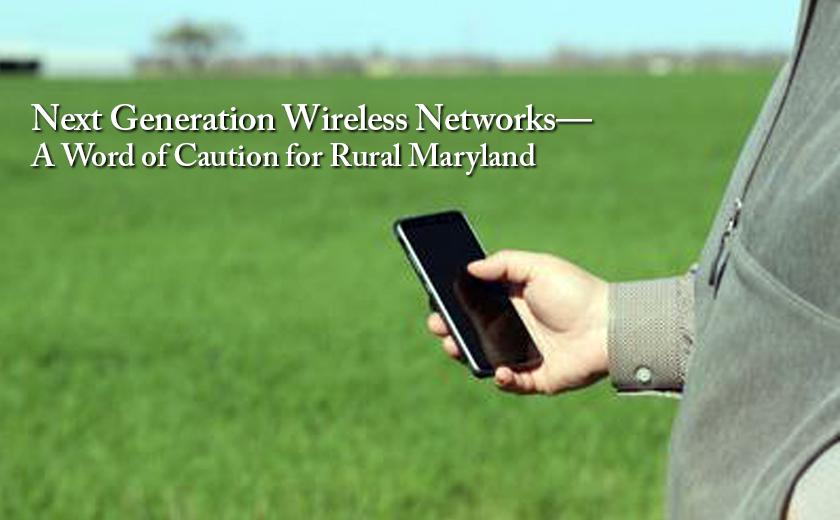On September 20, Apple will announce its new iphones, making a big point about the fact that they are equipped to use 5G mobile wireless networks and, likely, WiFi 6 wireless networks. A major selling point will be that these phones (and ipads and laptops)—operating on these new networks—can receive data much faster, able to download a high definition movie in a few seconds. New 5G capable Android devices (some already available) will make the same pitch. But before you rush out to upgrade your devices, there are some things you should consider.
5G mobile networks will indeed be much faster than the over-burdened mobile networks we have now, as much as 100 times faster. But the catch is, when will such networks be accessible to you? If you live on the Eastern Shore, the answer is not soon, likely not for some years to come. That’s because building out these networks will be much more expensive than the existing cellular networks, and the number of customers in rural areas may not justify the cost without federal or state subsidies.
5G networks operate on newly leased, higher frequencies that can transmit much more data.
The tradeoff is that they can only transmit that data over a much shorter distance (so that many more antennae—micro cell towers–are needed). The higher frequency mobile signals also don’t penetrate through walls as well as current, lower-frequency mobile signals. In densely-populated urban areas, 5G networks will likely need antennas on almost every street corner and still may not penetrate into the interior of office or residential buildings on those streets. So it will take several years to build out these new mobile networks, even in urban and suburban areas. And in rural areas—well, let’s just say, don’t hold your breath, because each of those short-range 5G antennas needs to be connected to an optical fiber backbone network. (just as current cell towers are). That means the real cost of a 5G network includes the cost of laying a lot of new optical fiber.
So buying an expensive new 5G-capable phone, unless you intend to spend a lot of time in cities or airports or sports stadiums, may not be worthwhile. Meanwhile, your 4G phone will continue to work, and may even work better in urban areas once more of the calls and downloads are being routed over 5G networks.
On the other hand, the new advanced version of WiFi—WiFi6—could turn out to be an immediate benefit, if you have a good fiber or cable internet connection to your home or place of business. That’s because WiFi6 is faster (up to 10 gigabits per second), can penetrate much further inside a building, can carry multiple kinds of traffic (phone calls, streaming video, video games) without confusion or dropped signals, and uses less energy. So buying a new WiFi6 router will eventually make a lot of sense (you won’t get the full benefit of the improvements until your devices are also upgraded to WiFi6, but the connectivity inside your house or business will be much better). WiFi6 also comes with upgraded security features, making hacking of your home network less likely.
Both 5G mobile networks and WiFi6 networks need to connect to an optical fiber or cable network—that’s where the real data traffic flows, especially across country or across the globe. The wireless networks are just intermediaries between your devices and the fiber. And if 5G isn’t going to be available anytime soon in rural areas such as the Eastern Shore, then WiFi6 will be your friend—especially if your children are learning remotely and your spouse is on Zoom calls all day and you want to stream a video.
Al Hammond was trained as a scientist (Stanford, Harvard) but became a distinguished science journalist, reporting for Science (a leading scientific journal) and many other technical and popular magazines and on a daily radio program for CBS. He subsequently founded and served as editor-in-chief for 4 national science-related publications as well as editor-in-chief for the United Nation’s bi-annual environmental report. More recently, he has written, edited, or contributed to many national assessments of scientific research for federal science agencies. Dr. Hammond makes his home in Chestertown on Maryland’s Eastern Shore.




Rick Skinner says
How does this analysis take into effect the potential effect of Choptank Co-Op Electric having the legal right to use its existing electrical connections to homes and businesses in its service area in Maryland to provide more robust Internet access than is now the case? Easton’s utility company provides Internet access and the town of Newnan in Georgia is
“fully-wired” for high-speed broadband and that was accomplished using the local utility company. While Choptank does not have the asset of a town with anything approaching high density, at least Saint Michaels proper could offer economies of scale via Choptank existing infrastructure and acquire better access.
Wilson Wyatt says
Question to Mr. Hammond: Many wireless customers on the Eastern Shore, like me, use satellite internet (like HughesNet). Does the same 5G problem exist for satellite as cable and the phone networks?
Edgar Smith says
Sticking with optical fiber is great advice, except some of us, who are only 4 miles outside of Easton, still depend on obsolete sketchy copper wire DSL from Verizon. From what I have read, we are included somewhere in a five-year project to bring optical fiber to our neighborhood, at a price yet to be determined.